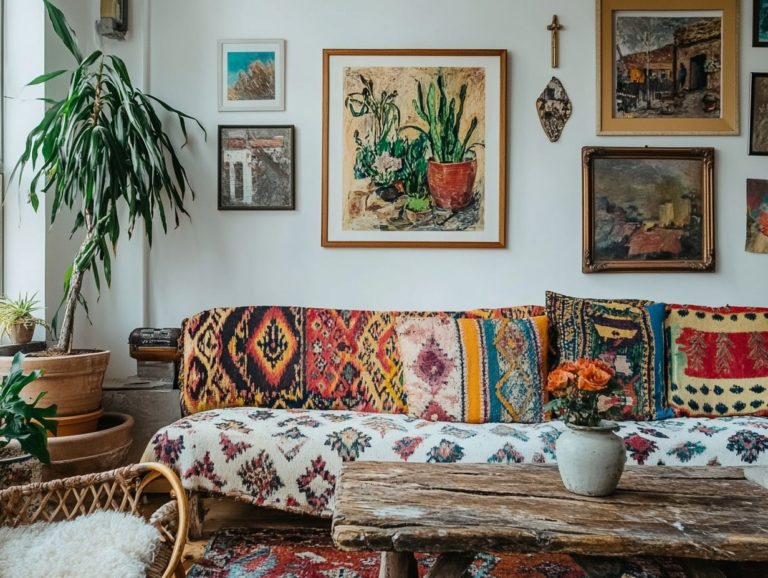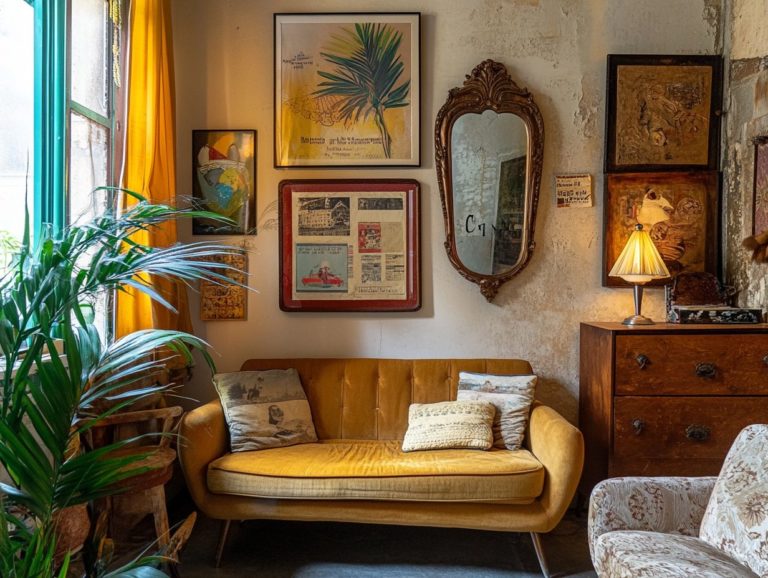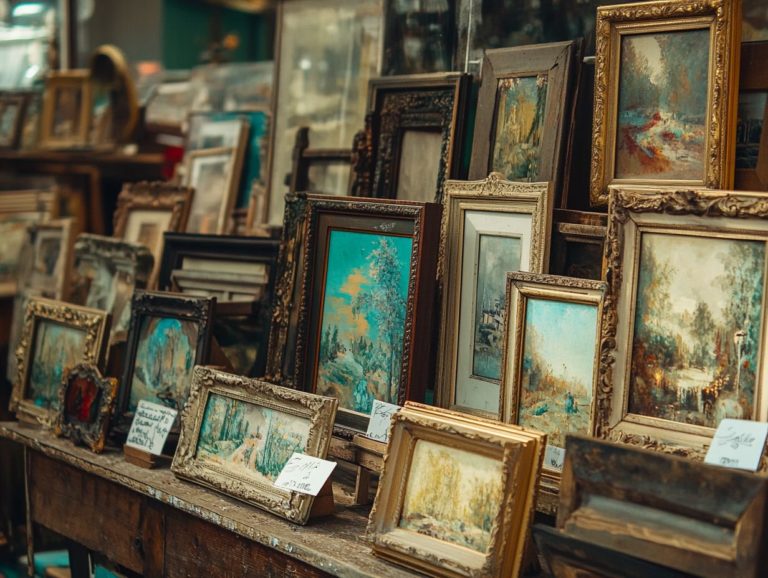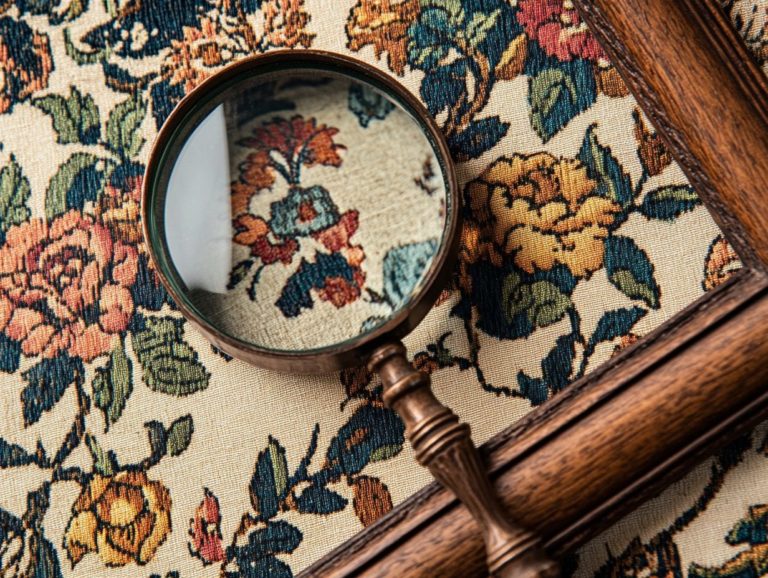Understanding Vintage Art Styles: A Beginner’s Guide
Vintage art possesses a rare allure, encapsulating the spirit of past eras through its distinctive styles and themes.
This article delves into the evolution of vintage art, shining a spotlight on pivotal periods and the influential artists who have shaped its rich landscape.
Discover now the defining characteristics of vintage art. Learn to identify its various styles and acquire invaluable insights into the nuances of collecting and preserving these treasures.
Whether you re an enthusiastic admirer or a seasoned collector, this guide will elevate your appreciation of vintage artistry to new heights.
Contents
Key Takeaways:

- Vintage art is an important part of our cultural heritage and understanding its evolution can enrich our appreciation of art.
- Vintage art styles are defined by their distinct characteristics, themes, and techniques that can be identified and appreciated through careful observation.
- Building a collection of vintage art requires knowledge, research, and proper care to preserve its value and significance.
Defining Vintage Art and its Significance
Vintage art serves as a compelling reflection of historical aesthetics, inviting you to celebrate designs that resonate with emotional power.
It often features unique logos, retro designs, and rich cultural histories that transport you to specific time periods, allowing you to revisit cherished memories through visual elements like intricate monograms and weathered lettering.
Artists such as Sarah Giffrow excel in this realm, showcasing the lasting allure of vintage aesthetics in contemporary graphic design. They seamlessly weave in elements that echo your childhood memories.
Vintage art is not just beautiful; it’s a powerful connection to our past. It plays an essential role in shaping brand identity and marketing strategies.
When companies embrace these retro designs, they communicate a sense of authenticity and timelessness, fostering a deeper emotional connection with consumers.
Brands convey resilience by incorporating vintage logos and styles, tapping into the emotional nostalgia that many crave. This emotional resonance can cultivate a loyal customer base.
These designs evoke shared experiences and feelings that transcend mere products, suggesting a return to simpler times and reinforcing a brand’s narrative in an increasingly saturated market.
The Evolution of Vintage Art
The evolution of vintage art unfolds through a variety of design styles that took shape across distinct eras, starting in the 1800s and extending through the 1900s, into the vibrant 1960s, and beyond.
During this journey, styles like pixel art and psychedelic colors emerged, seamlessly intertwining with the environmental benefits that accompany sustainable design practices.
Key Periods and Influential Artists
Key periods in the history of vintage art, particularly the 1960s and 1980s, are where you ll find some of the most influential artists harnessing methods used to create visual content to craft iconic vintage logos and retro designs.
These decades were alive with movements like Pop Art and Punk Design, which boldly pushed the boundaries of visual expression.
Notable figures such as Andy Warhol and Milton Glaser emerged during this time, using vibrant colors and innovative typography to capture the spirit of their eras.
You can see the impact of their work in vintage logos, like the classic Coca-Cola script and the sleek simplicity of the IBM logo. Both exemplify the power of minimalism and eye-catching aesthetics that defined this period.
These artistic contributions did more than just shape consumer culture; they laid the foundation for modern graphic design. Understanding these elements is essential to appreciating the rich identity of vintage art.
Characteristics of Vintage Art Styles

Vintage art styles are captivating. They feature unique decorative elements like distinctive typography, weathered lettering, and intricate monograms.
Each of these components collaborates to forge a classic aesthetic that resonates deeply, evoking nostalgia and stirring emotional connections within you.
Common Themes and Techniques
Common themes in vintage art invite you to explore nostalgia, emotional depth, and cultural history. These are masterfully conveyed through graphic design techniques that evoke memories of specific eras.
Warm color palettes and faded textures can stir a sense of longing for simpler times. They encourage you to reflect on past joys and sorrows.
Artists often use sepia tones or vintage typography to craft an atmosphere rich in history. Emotional resilience emerges as a significant undercurrent in their works.
They depict moments of triumph over adversity, suggesting that even amid change, the heart’s capacity to heal remains unwavering.
In this way, vintage art serves as a window into the past and a mirror reflecting the enduring human spirit.
Identifying and Appreciating Vintage Art
Appreciating vintage art requires understanding what makes it special. This includes the unique logos and compelling brand narratives behind heritage companies.
These aspects illuminate the cultural history and significance embedded within these artworks, enriching your appreciation of their value.
How to Recognize Different Styles
Recognizing different styles in vintage art requires discerning the various graphic design elements at play. Look for vintage logos, typography, and color palettes that evoke emotional resilience and nostalgia.
By paying close attention to the era each piece originates from, you can identify the distinct features that characterize diverse movements. For instance, you might appreciate Art Deco’s geometric elegance or the intricate detailing found in Victorian design.
Observing how line and shape interact with color can reveal much about the artist’s intentions and the cultural context of the time.
Familiarity with styles like mid-century modern can enhance your appreciation. This knowledge enables both budding collectors and seasoned enthusiasts to recognize the artistry of vintage wall art styles and craftsmanship that define these cherished vintage pieces.
Collecting and Preserving Vintage Art
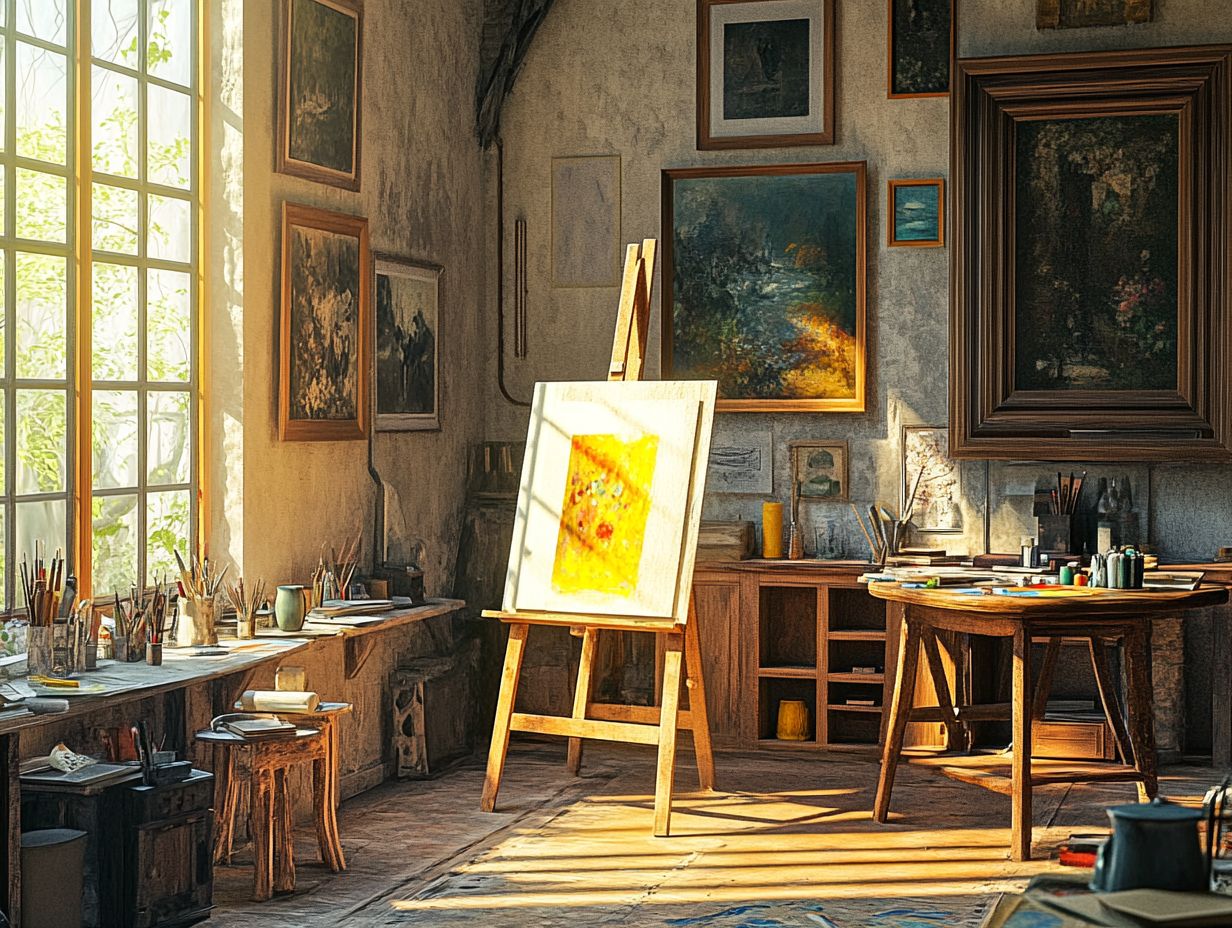
Collecting vintage art is a rewarding journey that requires careful attention to high-quality materials and sustainable construction techniques.
By prioritizing these elements, you can ensure the longevity and integrity of these exquisite artistic pieces, allowing them to be cherished for generations to come.
Tips for Building a Collection
Building a collection of vintage art demands a discerning eye for authenticity and market appeal. Focus on unique pieces that tell a compelling story.
Your journey as a collector often begins with meticulous research into reputable galleries and auction houses where authentic vintage art can be sourced. Understanding common vintage decor styles can also enhance your collection.
- Familiarize yourself with the historical context and the history of ownership of each piece. This knowledge can significantly elevate its value.
- When assessing quality, scrutinize the materials, craftsmanship, and overall condition. These factors play a crucial role in the longevity and allure of your collection.
- Stay informed about market trends and understand your motivations for collecting whether driven by passion, investment, or heritage. This will enable you to make well-informed decisions.
Curating a cohesive collection that resonates with you personally while reflecting contemporary trends will result in a collection that captivates and appreciates over time.
Don t miss the chance to find unique pieces that tell a story. Start your collection today!
Caring for Your Vintage Art
Proper care and display techniques are vital for preserving vintage art. Using high-quality materials and methods benefits the artwork while respecting the environment.
Attention to detail is crucial. The condition of vintage pieces can deteriorate swiftly without proper management. It’s important to keep an eye on factors like humidity and temperature. They play a big role in how your art lasts!
For example, maintaining a stable environment ideally around 70 degrees Fahrenheit and 50% humidity will work wonders in preventing damage.
Incorporating acid-free mats materials that won t harm your art over time and UV-filtering glass in your display frames can help reduce damage from light exposure. This ensures that those rich colors remain vibrant over time.
Regular cleaning with soft cloths will help protect the surface, allowing each vintage piece to age gracefully and remain a cherished part of your collection.
This video offers tips on how to care for vintage art and enhance its longevity.
Frequently Asked Questions
What is vintage art?

Vintage art refers to art styles that were popular or produced during a specific time period in the past, typically at least 20-30 years ago. It often reflects the cultural, social, and artistic trends of that time period.
Why is it important to understand vintage art styles?
Understanding vintage art styles allows us to appreciate and interpret the artwork in its historical context. It also helps us recognize the influences and evolution of art over time.
What are some popular vintage art styles?
Some popular vintage art styles include Art Nouveau, Art Deco, Surrealism, Impressionism, and Cubism. These styles emerged during different time periods and have distinct characteristics and techniques.
How can I identify vintage art?
The easiest way to identify vintage art is by looking at the style and technique used. You can also research the artist and time period to gain more insight into the artwork.
Are there any famous vintage artists?
Yes, many famous vintage artists, such as Vincent Van Gogh, Pablo Picasso, Claude Monet, and Salvador Dali, were pioneers in their respective art styles and have left a lasting impact on the art world.
Can I collect vintage art?
Yes, you can collect vintage art! However, it’s important to do thorough research and ensure the artwork is authentic and in good condition. It s also recommended to work with a reputable dealer or gallery when purchasing vintage art.
Explore more about vintage art and share your favorite pieces with us!

